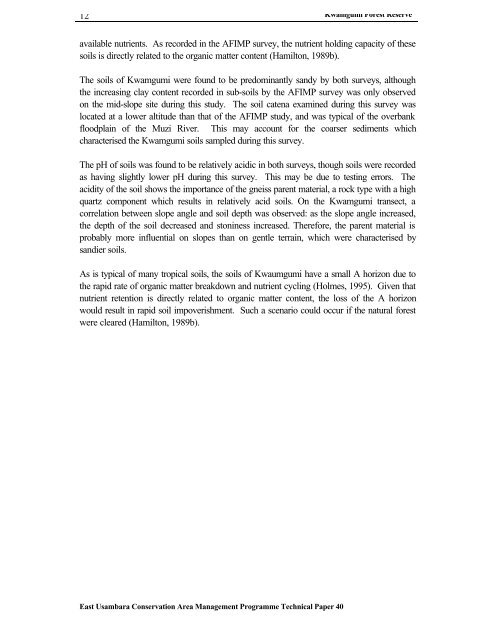Kwamgumi Forest Reserve - Frontier-publications.co.uk
Kwamgumi Forest Reserve - Frontier-publications.co.uk
Kwamgumi Forest Reserve - Frontier-publications.co.uk
Create successful ePaper yourself
Turn your PDF publications into a flip-book with our unique Google optimized e-Paper software.
12 <strong>Kwamgumi</strong> <strong>Forest</strong> <strong>Reserve</strong><br />
available nutrients. As re<strong>co</strong>rded in the AFIMP survey, the nutrient holding capacity of these<br />
soils is directly related to the organic matter <strong>co</strong>ntent (Hamilton, 1989b).<br />
The soils of <strong>Kwamgumi</strong> were found to be predominantly sandy by both surveys, although<br />
the increasing clay <strong>co</strong>ntent re<strong>co</strong>rded in sub-soils by the AFIMP survey was only observed<br />
on the mid-slope site during this study. The soil catena examined during this survey was<br />
located at a lower altitude than that of the AFIMP study, and was typical of the overbank<br />
floodplain of the Muzi River. This may ac<strong>co</strong>unt for the <strong>co</strong>arser sediments which<br />
characterised the <strong>Kwamgumi</strong> soils sampled during this survey.<br />
The pH of soils was found to be relatively acidic in both surveys, though soils were re<strong>co</strong>rded<br />
as having slightly lower pH during this survey. This may be due to testing errors. The<br />
acidity of the soil shows the importance of the gneiss parent material, a rock type with a high<br />
quartz <strong>co</strong>mponent which results in relatively acid soils. On the <strong>Kwamgumi</strong> transect, a<br />
<strong>co</strong>rrelation between slope angle and soil depth was observed: as the slope angle increased,<br />
the depth of the soil decreased and stoniness increased. Therefore, the parent material is<br />
probably more influential on slopes than on gentle terrain, which were characterised by<br />
sandier soils.<br />
As is typical of many tropical soils, the soils of Kwaumgumi have a small A horizon due to<br />
the rapid rate of organic matter breakdown and nutrient cycling (Holmes, 1995). Given that<br />
nutrient retention is directly related to organic matter <strong>co</strong>ntent, the loss of the A horizon<br />
would result in rapid soil impoverishment. Such a scenario <strong>co</strong>uld occur if the natural forest<br />
were cleared (Hamilton, 1989b).<br />
East Usambara Conservation Area Management Programme Technical Paper 40

















